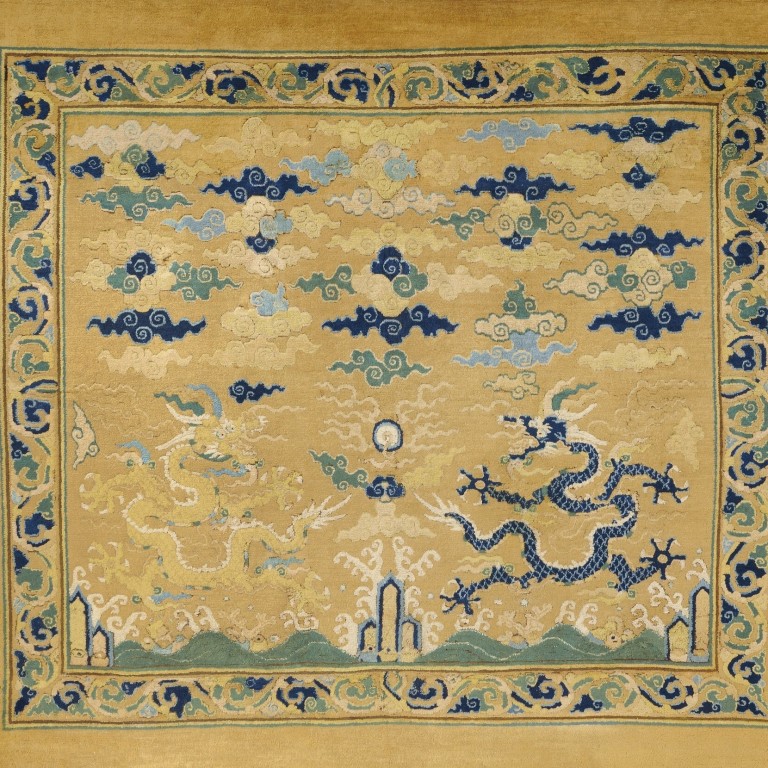
Ming dynasty carpet that may have graced the throne valued at US$5.4 million in upcoming Christie’s auction
- There are only 39 known intact carpets from the Ming dynasty and only 16 that feature an imperial dragon
- An American couple originally bought the carpet on their honeymoon in China in 1920 before it was sold to a person in Switzerland in 1987
A Ming dynasty-era carpet will be valued at between US$4.08 million and US$5.4 million at a Christie’s auction scheduled for November 23 in Paris.

Louise Broadhurst, a Christie’s rug and carpet specialist, said experts know that carpet probably was placed beneath the emperor’s throne because of “its size and photographic evidence that reveals carpets of this particular format placed on the raised kang on which the emperor’s throne would have been placed.”
She said that there is also some damage from a heavy screen that would have been placed directly behind the throne.
The carpet is one of 39 known intact carpets from the Ming dynasty and one of only 16 to feature the dragons, of which nine are exhibited in the Beijing Palace Museum. The other seven are owned privately.
“Standing before such a carpet, one cannot help but be transported back to the impressive palace interiors of the Ming Emperors,” said Broadhurst.
While enthusiasts enjoy these carpets today, it would have been nearly impossible for regular people to glimpse them during the Ming dynasty.
“This carpet would have been woven specifically for a hall within the Forbidden City and as such would not have been seen by anyone outside of the palace walls,” said Broadhurst. She said photographs of inside the Forbidden City emerged in 1906, where carpets could be seen throughout the palace.

An American couple originally bought the carpet on their honeymoon in China in 1920. They then loaned it to the Cleveland Museum of Art in the midwestern state of Ohio. When the couple sold their collection, the carpet was purchased by a private collector in Switzerland, who has owned it since.
While the carpet has a striking gold colour today, it would have been a rather stunning “imperial red” during its heyday.
Measuring 5x4 metres, it features an intricate border surrounding a city-and-hill scene along the lower edge. The two dragons dominate the bottom half of the composition, while the top half is a sky featuring about three dozen clouds.
“The carpets woven in the Imperial workshop during this period were predominantly woven with a thick, wool pile on either a cotton, silk or hemp foundation,” said Broadhurst.
The carpet was dated to around 1600 because it was similar in structure and design to other examples from that era. A handful of carpets had been carbon-dated to the Ming dynasty, providing a base to analyse other pieces.

13:46
Christie's Asia Pacific President on NFTs and the Basquiat craze
Experts believe hundreds of carpets were woven for the Ming emperors, but they were lost or destroyed at various historical moments.
East and West, a now-defunct academic quarterly, mentioned the Sacking of the Summer Palace in 1860 as a moment when many carpets could have been destroyed. While not close to the Forbidden City, it was considered the emperor’s primary residence, so it could have housed many carpets.
The journal’s clue for this theory was a large silk carpet from the Summer Palace that was sold for £504 (US$695) in 1879, equivalent to around US$46,000 in today’s money.
The journal also pointed to the Boxer Rebellion at the turn of the 20th century and the evacuation of art and valuables following Japan’s invasion of China in 1933 as likely moments when carpets were destroyed.
“For this carpet to have survived in such remarkable condition is in itself a rare feat and we are honoured to have the opportunity to offer this eminent work of art for sale,” said Broadhurst.
Last year, another Ming dynasty imperial carpet sold for US$1.7 million at a Christie’s auction in New York City. That carpet featured 260 repeating lotus blossoms in a square pattern across the entire piece.
That carpet was much larger than the one set to go on auction in November, suggesting it was probably used to adorn the hallways of the Forbidden City.
“It was a fabulous example but did not have the same rich iconography and design as the present carpet, which relates much more closely to the emperor himself and would have been the carpet on which he greeted his audience,” said Broadhurst.

